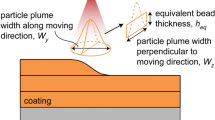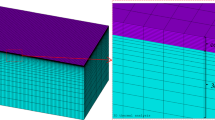Abstract
It is well known that grinding is a useful method to achieve a desired surface roughness for a WC-10Co-4Cr coating, deposited by high velocity oxygen fuel. In this study, the residual stress of the ground coating was determined via the x-ray diffraction technique, using the \(\sin^{2} \psi\) method and finite element method (FEM). The chemical layer removal process was used to experimentally measure the residual stress through the coating thickness. In finite element modeling of the grinding process, the temperature distribution of workpiece was initially determined by applying the heat flux obtained from grinding process. Then, the workpiece was cooled down to the ambient temperature. The temperature history of the thermal analysis was then used as an input to the stress modeling. The distribution of residual stress was finally determined by applying the grinding forces and residual stresses induced by the HVOF process. The experimental results, in accordance with the simulation results, illustrate that after the grinding process, the compressive residual stress of the coating surface increased significantly. The increase in residual stress after grinding was observed only to a specific depth of coating, measured from the surface. Below this depth, no increase was observed in compressive stress, up to the coating-substrate interface.






Similar content being viewed by others
Abbreviations
- \(a_{{\text{p}}}\) :
-
Depth of cut
- \(b_{{{\text{wp}}}}\) :
-
Width of cut
- \(c\) :
-
Specific heat capacity
- \(C\) :
-
Correction factor for temperature solution taking account of Peclet number, flux distribution and geometry
- \(d_{{\text{s}}}\) :
-
Diameter of the grinding wheel
- \(E_{{\text{s}}}\) :
-
Elastic module of the grinding wheel
- \(E_{{{\text{wp}}}}\) :
-
Elastic module of the workpiece
- \(E^{*}\) :
-
Equivalent elastic modulus for two bodies in contact
- \(F_{{\text{n}}}\) :
-
Normal force
- \(F_{{\text{t}}}\) :
-
Tangential force
- \(h_{{{\text{ch}}}}\) :
-
Convection coefficient of the chips
- \(h_{{\text{f}}}\) :
-
Convection coefficient of the cooling fluid
- \(h_{{{\text{wp}}}}\) :
-
Convection coefficient of the workpiece
- \(k\) :
-
Thermal conductivity
- \(k_{{\text{g}}}\) :
-
Density of the abrasive grains on the grinding wheel
- \(l_{{\text{c}}}\) :
-
Actual contact length
- \(l_{{\text{f}}}\) :
-
Contact length due to the force arising from deflection
- \(l_{{\text{g}}}\) :
-
Geometric contact length
- P :
-
Grinding power
- \(Pe\) :
-
Peclet number
- \(q_{{{\text{ch}}}}\) :
-
Chip heat flux
- \(q_{{\text{f}}}\) :
-
Cooling fluid heat flux
- \(q_{{\text{S}}}\) :
-
Grinding wheel heat flux
- \(q_{{\text{t}}}\) :
-
Total heat flux
- \(q_{{{\text{wp}}}}\) :
-
Workpiece heat flux
- \(r_{0}\) :
-
Radius of abrasive grains
- \(R_{{\text{r}}}\) :
-
Roughness factor
- \(T_{\max }\) :
-
Maximum temperature of the workpiece
- \(T_{{{\text{mp}}}}\) :
-
Melting point
- \(v_{{\text{c}}}\) :
-
Cutting speed
- \(v_{{\text{w}}}\) :
-
Speed of the workpiece
- \(\alpha_{{{\text{wp}}}}\) :
-
Thermal diffusivity for the workpiece
- \(\beta_{{\text{f}}}\) :
-
Thermal effusivity for transient heat conduction of the cooling fluid
- \(\beta_{{{\text{wp}}}}\) :
-
Thermal effusivity for transient heat conduction of the workpiece
- \(\mu\) :
-
Grinding force ratio
- \(\vartheta_{{\text{s}}}\) :
-
Poisson's ratio of grinding wheel
- \(\vartheta_{{{\text{wp}}}}\) :
-
Poisson's ratio of the workpiece
- \(\rho\) :
-
Density
References
M. Xie, S. Zhang and M. Li, Comparative Investigation on HVOF Sprayed Carbide-Based Coatings, Appl. Surf. Sci., 2013, 273, p 799–805. https://doi.org/10.1016/j.apsusc.2013.03.010
Y. Wu, B. Wang, S. Hong, J. Zhang, Y. Qin and G. Li, Dry Sliding Wear Properties of HVOF Sprayed WC-10Co-4Cr Coating, Trans. Indian Inst. Met., 2015, 68(4), p 581–586. https://doi.org/10.1007/s12666-014-0487-3
A.K. Maiti, N. Mukhopadhyay and R. Raman, Improving the Wear Behavior of WC-CoCr-Based HVOF Coating by Surface Grinding, J. Mater. Eng. Perform., 2009, 18(8), p 1060–1066. https://doi.org/10.1007/s11665-009-9354-5
S. Hong, Y.P. Wu, W.W. Gao, B. Wang, W.M. Guo and J.R. Lin, Microstructural characterisation and microhardness distribution of HVOF sprayed WC-10Co-4Cr coating, Surf. Eng., 2014, 30(1), p 53–58.
K. Murugan, A. Ragupathy, V. Balasubramanian and K. Sridhar, Optimizing HVOF Spray Process Parameters to Attain Minimum Porosity and Maximum Hardness in WC-10Co-4Cr Coatings, Surf. Coat. Technol., 2014, 247, p 90–102.
J.A. Picas, A. Forn and G. Matthäus, HVOF Coatings as an Alternative to Hard Chrome for Pistons and Valves, Wear, 2006, 261(5–6), p 477–484. https://doi.org/10.1016/j.wear.2005.12.005
W. Luo, U. Selvadurai and W. Tillmann, Effect of Residual Stress on the Wear Resistance of Thermal Spray Coatings, J. Therm. Spray Technol., 2016, 25(1–2), p 321–330. https://doi.org/10.1007/s11666-015-0309-0
J. Stokes and L. Looney, Residual Stress in HVOF Thermally Sprayed Thick Deposits, Surf. Coat. Technol., 2004, 177, p 18–23.
Y.Y. Santana, P.O. Renault, M. Sebastiani, J.G. La Barbera, J. Lesage, E. Bemporad, E. Le Bourhis, E.S. Puchi-Cabrera and M.H. Staia, Characterization and Residual Stresses of WC-Co Thermally Sprayed Coatings, Surf. Coatings Technol., 2008, 220, p 4560–4565.
J.K.N. Murthy, D.S. Rao and B. Venkataraman, Effect of Grinding on the Erosion Behaviour of a WC-Co-Cr Coating Deposited by HVOF and Detonation Gun Spray Processes, Wear, 2001, 249(7), p 592–600.
X. Liu and B. Zhang, Effects of Grinding Process of Residual Stresses in Nanostructured Ceramic Coatings, J. Mater. Sci., 2002, 37(15), p 3229–3239.
H. Masoumi, S.M. Safavi, M. Salehi and S.M. Nahvi, Effect of Grinding on the Residual Stress and Adhesion Strength of HVOF Thermally Sprayed WC-10Co-4Cr Coating, Mater. Manuf. Process., 2014, 29, p 1139–1151.
M.S. Zoei, M.H. Sadeghi and M. Salehi, Effect of Grinding Parameters on the Wear Resistance and Residual Stress of HVOF-Deposited WC-10Co-4Cr Coating, Surf. Coat. Technol., 2016, 307, p 886–891.
Q. Luo and A.H. Jones, High-Precision Determination of Residual Stress of Polycrystalline Coatings Using Optimised XRD-Sin2ψ Technique, Surf. Coat. Technol., 2010, 205, p 1403–1408.
G.S. Schajer, Practical Residual Stress Measurement Methods, Wiley, New York, 2013.
M.S. Zoei, T. Farizeh, M.H. Sadeghi and M. Salehi, Residual Stress Distribution Through the Thickness of WC-10Co-4Cr Coating Deposited by HVOF: Experimental and Simulation Study, J. Therm. Spray Technol., 2020, 29, p 1–14.
I.D. Marinescu, M. Hitchiner, E. Uhlmann, W.B. Rowe and I. Inasaki, Handbook of Machining with Grinding Wheels, CRC Press, Boca Raton, 2006.
D. Anderson, A. Warkentin and R. Bauer, Experimental Validation of Numerical Thermal Models for Dry Grinding, J. Mater. Process. Technol., 2008, 204(1–3), p 269–278.
H. Masoumi, S.M. Safavi and M. Salehi, Grinding Force, Specific Energy and Material Removal Mechanism in Grinding of HVOF-Sprayed WC-Co-Cr Coating, Mater. Manuf. Process., 2014, 29(3), p 321–330.
W.B. Rowe, Thermal Analysis of High Efficiency Deep Grinding, Int. J. Mach. Tools Manuf., 2001, 41(1), p 1–9.
A.M.O. Mohamed, A. Warkentin and R. Bauer, Variable heat flux in numerical simulation of grinding temperatures, Int. J. Adv. Manuf. Technol., 2012, 63(5–8), p 549–554.
T.J. Chuang, S. Jahanmir and H.C. Tang, Finite Element Simulation of Straight Plunge Grinding for Advanced Ceramics, J. Eur. Ceram. Soc., 2003, 23(10), p 1723–1733.
L. Pawlowski, The Science and Engineering of Thermal Spray Coatings, 2nd ed. Wiley, New York, 2008.
L.M. Berger, S. Saaro, T. Naumann, M. Wiener, V. Weihnacht, S. Thiele and J. Suchánek, Microstructure and Properties of HVOF-Sprayed Chromium Alloyed WC-Co and WC-Ni Coatings, Surf. Coatings Technol., 2008, 202, p 4417–4421.
M. Iordachescu, J. Ruiz Hervías, D. Iordachescu, A. Valiente Cancho, and L. Caballero Molano, Thermal Influence of Welding Process on Strength Overmatching of Thin Dissimilar Sheets Joints, Iberian Conference on Fracture and Structural integrity (CIFIE ), Oporto, Portugal, 2010
M. Alizadeh, H. Edris and A. Shafyei, Mathematical Modeling of Heat Transfer for Steel Continuous Casting Process, Int. J. ISSI, 2006, 3(2), p 7–16.
Author information
Authors and Affiliations
Corresponding author
Additional information
Publisher's Note
Springer Nature remains neutral with regard to jurisdictional claims in published maps and institutional affiliations.
Rights and permissions
About this article
Cite this article
Zoei, M.S., Farizeh, T. & Sadeghi, M.H. Effect of Grinding on the Distribution of Residual Stress through Thickness of WC-10Co-4Cr Coating Deposited by HVOF. J Therm Spray Tech 30, 1957–1967 (2021). https://doi.org/10.1007/s11666-021-01259-y
Received:
Revised:
Accepted:
Published:
Issue Date:
DOI: https://doi.org/10.1007/s11666-021-01259-y




